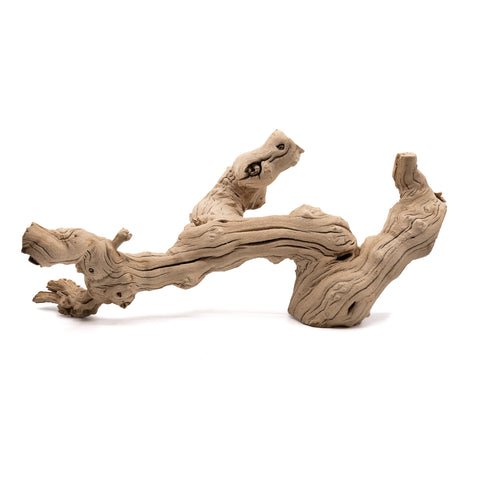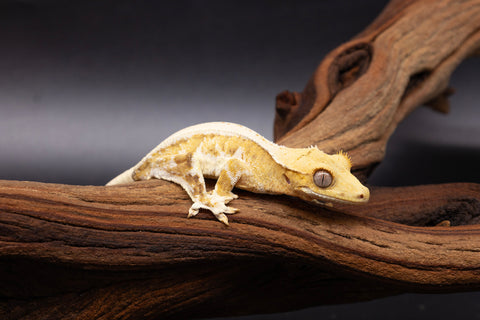Your Cart is Empty
Menu
-
- Live Animals
- Nutrition
- Habitats
- Habitat Supplies
- Light & Heat
- Humidity
- Husbandry
- Merch
-
- Contact Us
- Info
- Blog
- Professionals Login
- Gift Cards
- Login

Grapevine Branches vs Ghost Wood Branches - This or That?
April 09, 2024 3 min read

When building hardscape for your reptile or amphibian's enclosure, there are many varieties of branches to choose from. Of them, Grapevine and Ghost Wood are some of our favorite choices. However, these branches have different properties that make them better for some enclosures over others. Let's compare and contrast Grapevine and Ghost Wood to determine which is the right branch for your pet's enclosure!
You can also watch our video on the topic here!
The Branches:
To start, let's describe the branches themselves!

Grapevine that is sold as décor for the reptile and amphibian hobbies is a knobby light-colored wood harvested from vineyards as a by-product from grape production. It is sandblasted to remove its bark, and comes in wild knobby branchesand tunnels.

Ghostwood branches are the thicker pieces of wood harvested from Manzanita trees. It is also sandblasted to remove its bark, and is known for its colorful twisting branches. You can also purchase smaller Manzanita branches, though they lack the colored bands are not typically identified as Ghostwood.
Comparison Criteria:
To compare these woods, we will be going over their:
- Mold Resistance
- Sustainability
- Suitability for Different Species
- Cost
Mold Resistance:
Mold resistance is an important consideration for all reptile and amphibian enclosures, but especially so for high-humidity environments. Both of these wood varieties, as well as all décor should be regularly inspected and maintained to prevent mold buildup. In a bioactivesetup, a clean-up crew with Springtailsis a great addition to help keep the mold at bay!
Grapevine is less dense and more porous than Ghostwood, making it more susceptilbe to mold and fungal growth. Additionally, with all of it's twists, knobs, and divots, these branches can be difficult to cleanif mold buildup begins.
Ghostwood on the other hand, is dense and less porous making it more resistant to mold and decay. We will often use it in our high humidity enclosures due to its low maintenance requirements and the colors displayed when misted.

A hypo yellow Lilly White Crested Gecko on damp ghostwood.
Sustainability:
Both of these woods rank about the same in regards to sustainability.
Grapevine, in particular is a by-product of grape production. When used for reptile enclosures, these vines that would otherwise go to waste, find a new purpose as a reptile's favorite branch!
Ghostwood's harvesting practices can also be considered sustainable. Ghostwood is typically harvested from dead or dying trees in scrubland desert regions; primarily from areas where it would otherwise decompose. When done responsibly, it can be sustainable as it doesn't involve cutting down live trees and can help clean up natural areas.
Both variety's sustainability depends significantly on the harvesting practices employed, so not every sources of either wood type is guaranteed to be sustainable.
Suitability for Different Species:
Both varieties of wood are suitable for a wide range of reptile species.
Grapevine is highly versatile with its irregular shape and varying diameters. It offers excellent climbing opportunities for arboreal reptiles like chameleons, geckos, and some snakes. It does loose some points in this category due to its susceptibility to mold, however.
Ghostwood is also incredibly versatile, with its striking appearance and smooth texture lending itself well to many different enclosures. Branchier pieces make great climbing structures for arboreal reptiles, and larger pieces can make great basking spots for terrestrial reptiles. It also works great in both dry and wet environments with a desert-like appearance when dry and rich colors when wet.
Cost:
Cost is, of course going to be a major determining factor for many keepers.
Grapevine is generally the more affordable option of the two. Being a byproduct of the grape industry helps keep supply up, driving cost down. Larger, more complex pieces of grapevine will cost more, but less so than similar pieces of more premium woods.
Speaking of premium, Ghostwood falls neatly into that category. It's unique appearance, durability, and the process involved in harvesting and preparing it all contribute to its premium price tag. But, if you are willing to invest in it, its striking appearance, and lower need for maintenance make it well worth it!
Our Recommendations:
So, which branch is right for you?
If you are looking for an affordable option for a reptile without high humidity requirements, then Grapevine is a great choice for you!
If you are looking for a more visually striking branch that looks great in any environment, that holds up to high humidity, and cost is not an issue, than Ghostwood is a fantastic option.
There is also no reason a combination of the two can't be used! If the enclosure is suited for it, using both Grapevine and Ghostwood can provide some great contrast, giving your reptile more variety, and your eye more visual interest!
